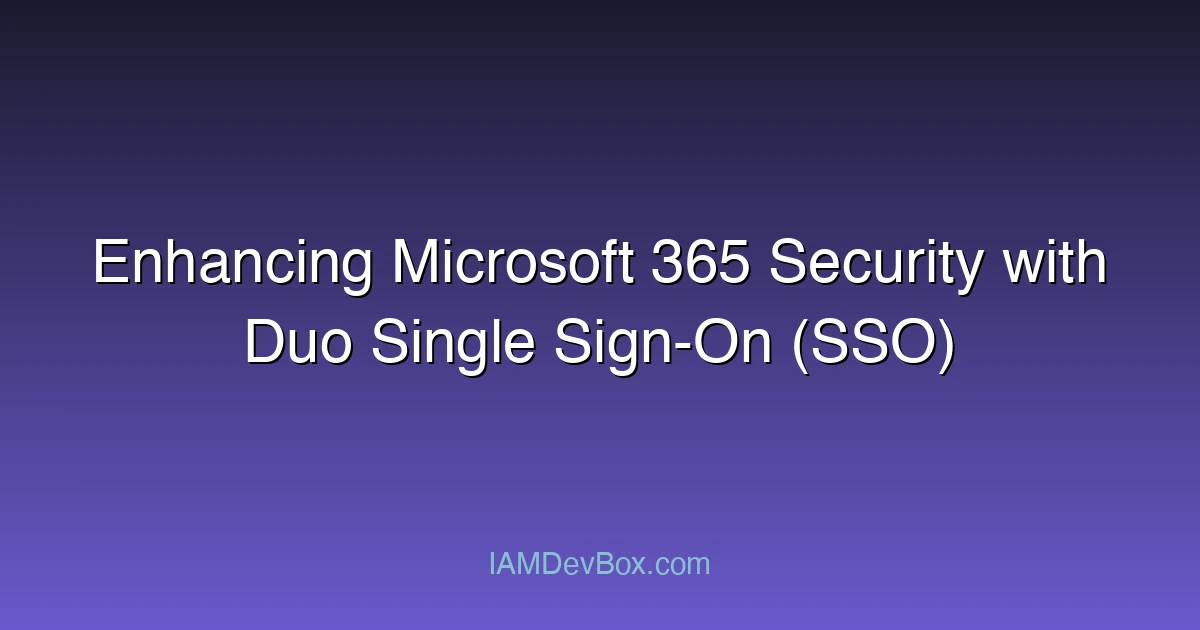Visual Overview:
sequenceDiagram
participant User
participant SP as Service Provider
participant IdP as Identity Provider
User->>SP: 1. Access Protected Resource
SP->>User: 2. Redirect to IdP (SAML Request)
User->>IdP: 3. SAML AuthnRequest
IdP->>User: 4. Login Page
User->>IdP: 5. Authenticate
IdP->>User: 6. SAML Response (Assertion)
User->>SP: 7. POST SAML Response
SP->>SP: 8. Validate Assertion
SP->>User: 9. Grant Access
In today’s digital landscape, Microsoft 365 has become the backbone of many organizations, housing sensitive data and critical applications. As cyber threats evolve, ensuring robust security measures for Microsoft 365 is no longer an option but a necessity. Enter Duo Single Sign-On (SSO), a solution that not only enhances security but also streamlines user access. This blog explores how integrating Duo SSO with Microsoft 365 can fortify your organization’s security posture.
Understanding Single Sign-On (SSO)
Single Sign-On (SSO) is a authentication mechanism that allows users to access multiple applications with a single set of credentials. This eliminates the need for remembering multiple passwords, reducing friction and enhancing user experience. SSO works by authenticating a user once and then propagating that authentication across all connected systems.
Diagram: How SSO Works
User → Authenticates → SSO Provider → Grants Access → Applications
While SSO simplifies access, it’s crucial to differentiate it from Multi-Factor Authentication (MFA). MFA adds an extra layer of security by requiring multiple verification methods, such as a password and a biometric scan, whereas SSO focuses on seamless access across applications.
Integrating Duo with Microsoft 365
Duo Security, renowned for its robust MFA solutions, extends its capabilities with SSO, offering a comprehensive security layer for Microsoft 365. Here’s how you can integrate Duo SSO:
-
Setup Duo as an Identity Provider (IdP):
- Configure Duo as your organization’s IdP within Azure Active Directory (AD).
- Code Snippet: Azure AD Configuration
<Configuration> <IdPMetaData> <EntityDescriptor entityID="https://api.duo.com"> <IDPSSODescriptor protocolSupportEnumeration="urn:oasis:names:tc:SAML:2.0:protocol"> <SingleSignOnService Binding="urn:oasis:names:tc:SAML:2.0:bindings:HTTP-Redirect" Location="https://api.duo.com/saml/v1/sso"/> </IDPSSODescriptor> </EntityDescriptor> </IdPMetaData> </Configuration>
-
Configure Microsoft 365:
- Link Azure AD with Duo, ensuring seamless SSO and MFA integration.
- Troubleshooting Tip: Ensure SAML settings are correctly configured to avoid login issues.
-
User Enrollment:
- Guide users through Duo enrollment, setting up their preferred authentication methods.
Real-World Benefits
Organizations leveraging Duo SSO have reported significant security improvements. For instance, a healthcare provider reduced unauthorized access incidents by 40% post-implementation. Duo’s integration with other security tools, such as SIEM platforms, enhances threat detection and response.
Case Study: A financial services company integrated Duo SSO, reducing their breach risk by 35% and improving compliance with regulatory standards.
Implementation Best Practices
-
User Education:
- Conduct training sessions and phishing simulations to familiarize users with Duo SSO and MFA.
-
Monitor and Maintain:
- Regularly review logs and utilize tools like Azure AD Reports to identify and address security gaps.
-
Adopt a Zero Trust Approach:
- Continuously verify user identities and enforce granular access controls.
Conclusion
Duo SSO for Microsoft 365 is a pivotal solution in the quest for robust cloud security. By enhancing security without compromising user experience, Duo empowers organizations to safeguard their digital assets effectively.
Extended Questions for Readers:
- How has your organization’s approach to cloud security evolved recently?
- What challenges have you encountered in implementing SSO solutions?
Start your journey to enhanced security with Duo SSO. For more details, visit Duo’s official site or contact their support team.
